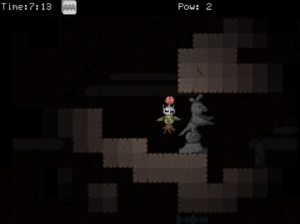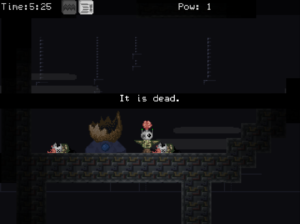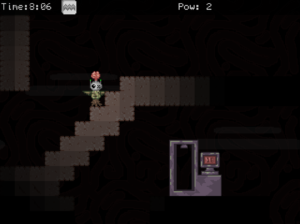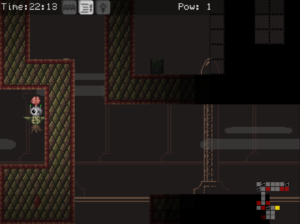
Abandoned may have one of the worst names possible for search engines, but the game itself is far from incomplete. Your only adversary in this bleak Metroidvania is time, but it is an opponent which should not be taken lightly as you rush through labyrinthine passages in a desperate attempt to escape the poisonous environment.
This is an exploration game in the truest sense of the word. Playing as a bizarre flying plant/bird/robot creature, the game gives you virtually no context for who you are, where you are, or even what you’re meant to do. All you know is that your character has hatched from a giant egg hooked up to machinery and that there’s a timer slowly yet steadily counting down. With no other lore to speak of and only a handful of environmental objects to interact with (puzzle objects not included), it is up to you to make what you will of the sometimes mechanical, sometimes biological, and altogether disturbing and unpleasant environments you find yourself in.
Tangible progress in Abandoned comes in three main forms. The most crucial yet also the least necessary things to find are oxygen tanks scattered throughout the map. You don’t need to find every oxygen tank in the game, but each tank gives you ten more minutes and, considering the facts that the game starts with only ten minutes on the clock and my completion time came in at slightly over an hour and a half, you’ll definitely need at least a few of them even if you have somehow memorized the entire game. The second type of upgrade is light; you start out only being able to see in a faint circle around your character, but each light upgrade makes that circle a little bit bigger and a little brighter. It may sound odd to say that increased visibility is more important than increasing the amount of time you have left to live, but it makes sense once you start trying to weave through branching paths and need to overcome some of the more complicated obstacles the game throws your way.

The final main way of progressing in Abandoned is through finding and upgrading abilities. Even though your character can fly and you don’t need to worry about taking damage from enemies or other hazards there are still many uses for your new powers. The first and most frequently useful ability you are likely to stumble across is the green laser power, which lets you shoot a laser horizontally, but not vertically. Finding additional copies of this ability boosts its power and the map is littered with green blocks which can only be destroyed if you have the green laser at a level equal to or greater than the number written on the block. However, blocks respawn once you leave a room and since you can only shoot horizontally you frequently must figure out a way to shoot blocks from one part of the room and then find out how to work your way over to the newly opened passage. Another early and crucial ability at your disposal is a dash which, in addition to helping you save a significant amount of time, can be upgraded to destroy red blocks at or below its level.
A good number of additional abilities exist which help you to manipulate certain blocks or interact with the environment in new ways, but, as I do not want to spoil all the surprises this exploration-heavy game has in store for its players, the last ability I will discuss is the torch. This ability allows your character to glow and can be used to destroy a few specific blocks of its own, yet the main advantage it provides is it reveals fake walls and unmasks any destructible blocks within walls. The torch is especially important to this game because fake walls and hidden blocks are everywhere and it serves to counterbalance the dash while playing; you can choose to dash through rooms on your way to your destination and possibly miss a hidden path along the way or you can choose to examine your environments with the torch even though doing so means moving at your default speed with the timer constantly ticking away. The presence of the torch ability is also a large part of why seeking out items to boost your visibility is so important because the torch has a rather large radius and being able to see everything which it is revealing all at once without needing to be right next to a secret can go a long way towards saving time.

You’ll encounter several obstacles on your journey, but, with the possible exception of the various ability-related blocks, the most common obstacles are floating sets of directional arrows. These arrows come in three colors, but they all serve to create one-way passages by pushing you in the direction they are facing. Blue arrows are the most common color for this common obstacle and every blue arrow in your current room will simultaneously reverse its direction when you flip a switch. Blue arrows reset to their default position once you leave a room and they usually serve to either prevent you from destroying blocks unless you enter a room from a specific location or to form puzzle mazes where you must find and flip switches to reverse and reorient the sets of arrows along your path. Red arrows also reverse their direction when you flip a switch, but in their case every red arrow in the entire game changes the way it is facing so finding a red switch in one room may be required in order to create a path in a completely different room. Lastly, green arrows simply can’t be affected at all so if a green arrow is blocking a path or an item you’ll need to swap around the other arrows in the room or find an entirely different path to get to where you want to go. Arrow puzzles are never particularly difficult to solve, but they make it much more difficult to memorize a path when backtracking through the already maze-like rooms of previous areas and taking a wrong turn down a one-way path can add a significant sense of tension to the oppressive atmosphere as you rush around attempting to find your way back on to the right track as your remaining time gets ever lower. Like with the torch ability, arrows and switches are also yet another way in which visibility upgrades prove themselves useful because being able to see more of the screen lets you find switches more quickly and makes it possible to figure out the path through each set of arrows as well as just where that path will take you.

The biggest strength of Abandoned is just how well it builds its environment and atmosphere. Music plays a huge role in creating a bleak and utterly unwelcoming atmosphere from the moment you start a new game. Every track is filled with discordant, broken melodies, strange background noises, and abrupt, piercingly sharp notes. It’s a soundtrack designed from start to finish to convey a sense of deep, unsettling wrongness which comes across so clearly that even if you couldn’t see the game you would immediately be able to tell that the protagonist is not at all in a safe place. Speaking of the protagonist, the graphics carry their own fair share of the weight when it comes to establishing a ton. Whether the backgrounds are of abandoned machinery covered in fog or look like enormous pulsing veins (complete with a heartbeat sound effect), all of the locations in this game carry a sense of passive menace and the initially low visibility only serves to heighten the effect. Even your protagonist looks like an unfinished abomination which should not exist with his exposed brain and root-like legs and you’ll find the corpses of many such creatures next to broken eggs around the map (the description on the official website states that the character is “the result of a failed genetical experient [sic]” though this is never explicitly mentioned in-game). Abandoned has an aesthetic which simply excels at creating a dark and deeply disturbing atmosphere every step of the way and to this day few games can come close to matching it in this regard.

Aesthetics aren’t the only aspect of environmental building which this game has going for it because it is also quite good at physically shaping its environment too. The very first room of the game only initially provides you with one way to go, but it also crams in three different types of blocks, a broken egg which you can examine, a mysterious bird statue, and a set of blue arrows which prevent you from going down a different path. Not only does this room serve to pique your curiosity by placing all of these mysterious objects near your field of vision, but it also serves as an excellent hint that backtracking is going to be an important part of this game and that you should start looking out for these objects and making mental notes of their locations. There is also a strange sense of ‘balance’ to the map design of the game as the overall shape of the map is that of a large square divided neatly into four distinct regions which are themselves made up of square-shaped rooms to make navigation on a large and general scale very easy, but the rooms themselves are all large enough to span many screens and their various paths filled with many exits and entrances alongside mazes of limiting arrows give the actual act of navigating to specific locations a more chaotic and confusing nature than the sterile shape of the map as a whole dares to betray.

Exploration within these environments is surprisingly open and provides more than just the illusion of freedom found in many Metroidvanias. Sometimes your progress really is blocked off until you find or upgrade a specific ability, but the exact order in which you acquire these abilities is somewhat flexible. In fact, there are a few items and parts of the map which are entirely optional, though choosing to rush for the exit as quickly as possible certainly won’t get you a very good ending. To help take away some of the tension involved in exploration, save points are present in many of the rooms and, if you ever make a time-wasting mistake, the process of returning to the main menu and reloading your save is very fast and painless (and you only have one save file unless you make a backup, so learning when to give up and reload is incredibly important if you want to avoid backing yourself into a corner where you have no possible way of finishing in time). Furthermore, there is a map item which can be acquired near the start of the game, though it is also fairly easy to miss it until later on, and this map will put an ‘S’ in every room with a save point in addition to marking rooms in red if they still have a valuable upgrade or an oxygen tank in them, but there are also a few rooms which are off the map and a few optional upgrades and objectives which it doesn’t mark at all. Overall, the only point where the exploration-based and time-intensive gameplay suffers is with the odd lack of any sort of a pause button; even minimizing the game doesn’t stop the timer and there were definitely a few times when I had to quit and reload my save simply because I had to step away from the computer for a moment rather than for any mistake made on my part within the game itself.

With a masterfully disturbing atmosphere and a huge world to explore under an ever-present time limit with absolutely no hand-holding whatsoever, Abandoned teaches us that a game doesn’t always need physical threats to provide a difficult challenge and that characters and dialogue aren’t always necessary when the environment itself can be effectively used to create an emotionally-engaging experience.